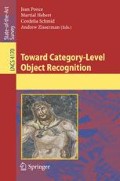Abstract
We present a method for object categorization in real-world scenes. Following a common consensus in the field, we do not assume that a figure-ground segmentation is available prior to recognition. However, in contrast to most standard approaches for object class recognition, our approach automatically segments the object as a result of the categorization.
This combination of recognition and segmentation into one process is made possible by our use of an Implicit Shape Model, which integrates both capabilities into a common probabilistic framework. This model can be thought of as a non-parametric approach which can easily handle configurations of large numbers of object parts. In addition to the recognition and segmentation result, it also generates a per-pixel confidence measure specifying the area that supports a hypothesis and how much it can be trusted. We use this confidence to derive a natural extension of the approach to handle multiple objects in a scene and resolve ambiguities between overlapping hypotheses with an MDL-based criterion.
In addition, we present an extensive evaluation of our method on a standard dataset for car detection and compare its performance to existing methods from the literature. Our results show that the proposed method outperforms previously published methods while needing one order of magnitude less training examples. Finally, we present results for articulated objects, which show that the proposed method can categorize and segment unfamiliar objects in different articulations and with widely varying texture patterns, even under significant partial occlusion.
Access this chapter
Tax calculation will be finalised at checkout
Purchases are for personal use only
Preview
Unable to display preview. Download preview PDF.
References
Agarwal, S., Roth, D.: Learning a sparse representation for object detection. In: Heyden, A., Sparr, G., Nielsen, M., Johansen, P. (eds.) ECCV 2002. LNCS, vol. 2353, pp. 113–127. Springer, Heidelberg (2002)
Ballard, D.H.: Generalizing the hough transform to detect arbitrary shapes. Pattern Recognition 13(2), 111–122 (1981)
Borenstein, E., Ullman, S.: Class-specific, top-down segmentation. In: Heyden, A., Sparr, G., Nielsen, M., Johansen, P. (eds.) ECCV 2002. LNCS, vol. 2351, pp. 109–122. Springer, Heidelberg (2002)
Burl, M.C., Weber, M., Perona, P.: A Probabilistic Approach to Object Recognition Using Local Photometry and Global Geometry. In: Burkhardt, H., Neumann, B. (eds.) ECCV 1998. LNCS, vol. 1407, p. 628. Springer, Heidelberg (1998)
Cheng, Y.: Mean shift mode seeking and clustering. Trans. PAMI 17(8), 790–799 (1995)
Comaniciu, D., Meer, P.: Distribution free decomposition of multivariate data. Pattern Analysis and Applications 2(1), 22–30 (1999)
Cootes, T.F., Edwards, G.J., Taylor, C.J.: Active appearance models. In: Burkhardt, H., Neumann, B. (eds.) ECCV 1998. LNCS, vol. 1407, p. 484. Springer, Heidelberg (1998)
Fergus, R., Zisserman, A., Perona, P.: Object class recognition by unsupervised scale-invariant learning. In: CVPR 2003 (2003)
Garg, A., Agarwal, S., Huang, T.: Fusion of global and local information for object detection. In: ICPR 2002, pp. 723–726 (2002)
Harris, C., Stephens, M.: A combined corner and edge detector. In: Alvey Vision Conference, pp. 147–151 (1988)
Jones, M., Poggio, T.: Model-based matching by linear combinations of prototypes. In: MIT AI Memo 1583. MIT Press, Cambridge (1996)
Leibe, B., Leonardis, A., Schiele, B.: Combined object categorization and segmentation with an implicit shape model. In: ECCV 2004 Workshop on Stat. Learn. in Comp. Vis, Prague, Czech Republic, May 2004, pp. 17–32 (2004)
Leibe, B., Schiele, B.: Interleaved object categorization and segmentation. In: BMVC 2003, Norwich, UK, pp. 759–768 (September 2003)
Leibe, B., Schiele, B.: Scale-Invariant Object Categorization Using a Scale-Adaptive Mean-Shift Search. In: Rasmussen, C.E., Bülthoff, H.H., Schölkopf, B., Giese, M.A. (eds.) DAGM 2004. LNCS, vol. 3175, pp. 145–153. Springer, Heidelberg (2004)
Leibe, B., Seemann, E., Schiele, B.: Pedestrian detection in crowded scenes. In: CVPR (2005)
Leonardis, A., Gupta, A., Bajcsy, R.: Segmentation of range images as the search for geometric parametric models. IJCV 14, 253–277 (1995)
Lowe, D.G.: Object recognition from local scale invariant features. In: ICCV 1999 (1999)
Magee, D., Boyle, R.: Detecting lameness using re-sampling condensation and multi-stream cyclic hidden markov models. Image and Vision Computing 20(8), 581–594 (2002)
Mohan, A., Papageorgiou, C., Poggio, T.: Example-based object detection in images by components. Trans. PAMI 23(4), 349–361 (2001)
Papageorgiou, C., Poggio, T.: A trainable system for object detection. IJCV 38(1), 15–33 (2000)
Schmid, C.: Constructing models for content-based image retrieval. In: CVPR 2001 (2001)
Schneiderman, H., Kanade, T.: A statistical method of 3d object detection applied to faces and cars. In: CVPR 2000, pp. 746–751 (2000)
Ullman, S.: Three-dimensional object recognition based on the combination of views. Cognition 67(1), 21–44 (1998)
Viola, P., Jones, M.: Rapid object detection using a boosted cascade of simple features. In: CVPR 2001, pp. 511–518 (2001)
Weber, M., Welling, M., Perona, P.: Unsupervised learning of models for recognition. In: Vernon, D. (ed.) ECCV 2000. LNCS, vol. 1842, pp. 18–32. Springer, Heidelberg (2000)
Yu, S.X., Shi, J.: Object-specific figure-ground segregation. In: CVPR 2003 (2003)
Yuille, A.L., Cohen, D.S., Hallinan, P.W.: Feature extraction from faces using deformable templates. In: CVPR 1989 (1989)
Author information
Authors and Affiliations
Editor information
Editors and Affiliations
Rights and permissions
Copyright information
© 2006 Springer-Verlag Berlin Heidelberg
About this chapter
Cite this chapter
Leibe, B., Leonardis, A., Schiele, B. (2006). An Implicit Shape Model for Combined Object Categorization and Segmentation. In: Ponce, J., Hebert, M., Schmid, C., Zisserman, A. (eds) Toward Category-Level Object Recognition. Lecture Notes in Computer Science, vol 4170. Springer, Berlin, Heidelberg. https://doi.org/10.1007/11957959_26
Download citation
DOI: https://doi.org/10.1007/11957959_26
Publisher Name: Springer, Berlin, Heidelberg
Print ISBN: 978-3-540-68794-8
Online ISBN: 978-3-540-68795-5
eBook Packages: Computer ScienceComputer Science (R0)

